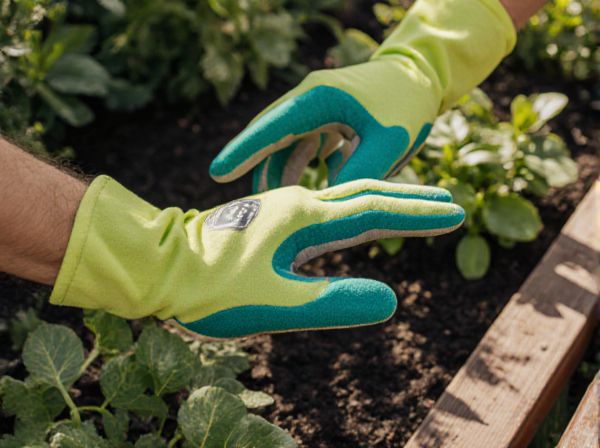
Benching vs In-ground Planting Illustration
Benching in greenhouses offers elevated, controlled environments that improve air circulation and reduce soil-borne diseases compared to in-ground planting. In-ground planting allows plants to access natural soil nutrients and moisture but may face challenges like pest intrusion and uneven growing conditions. Choosing between benching and in-ground planting depends on factors like crop type, space efficiency, and disease management priorities.
Table of Comparison
| Aspect | Benching | In-ground Planting |
|---|---|---|
| Definition | Plants grown on elevated benches inside greenhouse | Plants grown directly in the greenhouse soil |
| Space Efficiency | High; maximizes vertical space | Moderate; uses ground area only |
| Drainage | Controlled drainage; reduces waterlogging | Dependent on soil type; risk of poor drainage |
| Soil Control | Use of customized growing media | Limited; relies on existing soil quality |
| Pest and Disease Management | Lower risk; easier monitoring | Higher risk; soil-borne pathogens possible |
| Labor Intensity | Lower; easier access and maintenance | Higher; requires bending and soil preparation |
| Initial Cost | Higher due to bench installation | Lower; minimal setup |
| Suitable Crops | Herbs, ornamentals, seedlings | Vegetables, root crops |
| Growth Control | Better management of plant environment | Less control; affected by soil conditions |
Introduction to Benching and In-Ground Planting
Benching in greenhouses involves growing plants on raised platforms or benches, optimizing space and improving air circulation, which helps reduce disease risk and simplifies crop management. In-ground planting utilizes the natural soil within the greenhouse, allowing deeper root development and often supporting larger plants with better access to nutrients and moisture. Both methods influence plant growth dynamics, pest management, and maintenance practices depending on the crop type and greenhouse design.
Key Differences Between Benching and In-Ground Methods
Benching in greenhouses involves growing plants on raised platforms or tables, which offers improved air circulation, easier pest management, and enhanced control over irrigation and drainage compared to in-ground planting. In-ground planting utilizes the natural soil bed, providing greater root space and lower initial setup costs but often faces challenges with soil-borne diseases and inconsistent moisture levels. Key differences include the level of environmental control, disease risk, maintenance requirements, and initial investment, making benching more suitable for high-value or sensitive crops while in-ground planting suits larger-scale or traditional production systems.
Pros and Cons of Greenhouse Benching
Greenhouse benching offers elevated plant organization, improved air circulation, and easier pest management compared to in-ground planting, reducing soil-borne diseases and enhancing crop quality. However, benching may limit root expansion and requires consistent irrigation management to prevent drying out, which can increase labor intensity and water use. Elevated benches also involve higher initial setup costs and may restrict the cultivation of deep-rooted plants.
Advantages of In-Ground Planting in Greenhouses
In-ground planting in greenhouses offers superior root growth due to natural soil conditions, enhancing plant health and yield. It provides better water retention and nutrient availability compared to benching systems, reducing irrigation frequency and fertilizer use. The thermal mass of soil in-ground helps maintain stable temperatures, promoting consistent growth in controlled environments.
Space Utilization: Maximizing Greenhouse Capacity
Benching in greenhouses optimizes space utilization by elevating plants on tiered benches, allowing for increased vertical growing area and improved airflow. In-ground planting uses the greenhouse floor efficiently for deep-rooted crops but limits vertical space and may reduce overall plant density. Maximizing greenhouse capacity involves balancing benching systems for high-density growth with in-ground beds for larger or permanent plants.
Soil Health and Disease Control Considerations
Benching in greenhouses enhances soil health by allowing better air circulation and drainage, reducing the risk of soil compaction and root diseases such as Pythium and Phytophthora. In-ground planting often leads to soilborne pathogens accumulating over time, increasing the potential for disease outbreaks and nutrient imbalances. Regular soil sterilization and crop rotation practices are more easily managed in benching systems, promoting sustainable disease control and healthier plant growth.
Irrigation Systems for Benched vs In-Ground Plants
Irrigation systems for benched plants in greenhouses often utilize drip or ebb-and-flow methods to ensure precise water delivery and reduce soil disease risks. In-ground planting relies more on drip irrigation or overhead sprinklers, which require careful management to prevent water runoff and uneven moisture distribution. Optimizing irrigation technology according to planting method enhances water efficiency and promotes healthy plant growth.
Crop Selection: Best Plants for Each Planting Method
Benching in greenhouses favors delicate, high-value crops such as leafy greens, herbs, and seedlings that require precise environmental controls and easy access for monitoring. In-ground planting suits larger, deep-rooted plants like tomatoes, peppers, and cucumbers, which benefit from the natural soil ecosystem and greater root space. Selecting crops based on planting methods enhances yield quality by aligning growth habits with optimal cultural conditions.
Maintenance and Labor Requirements Compared
Benching in greenhouses reduces maintenance by centralizing plants on elevated platforms, facilitating easier watering, pruning, and pest control with less physical strain. In-ground planting demands higher labor inputs due to soil preparation, weeding, and more complex irrigation management, often leading to increased time and effort. Efficient benching systems optimize space and simplify routine tasks, lowering overall labor requirements compared to traditional in-ground cultivation.
Choosing the Right Method for Your Greenhouse
Benching in greenhouses maximizes space efficiency by elevating plants, improving air circulation, and facilitating easier maintenance, which is ideal for smaller areas or intensive crop production. In-ground planting leverages natural soil properties, promoting stronger root development and better moisture retention, suitable for larger operations with consistent ground conditions. Selecting the right method depends on greenhouse size, crop type, and environmental control capabilities to optimize plant growth and resource use.
Benching vs In-ground Planting Infographic

 gardendif.com
gardendif.com